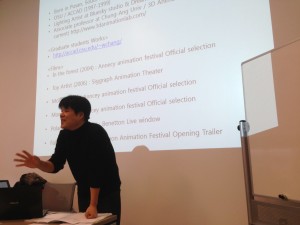“I like you, your eyes are full of language.” – Anne Sexton
I am a professor at Chung Ang University in Korea and I came to ACCAD / Ohio State University in Columbus, OH (The United States) to teach computer graphic animation for my sabbatical year.
Before I came to OSU, I was quite worried about teaching a class in English because I have not spoken English since 2003. My friends and family also wondered how I would communicate with the students.
As soon as I arrived in the United States, I knew that my English was worse than I expected. I listened to people speak but it was hard for me to understand what was being said. When I tried to speak, no words would come out of my mouth.
I knew that there were no more seats available in my class. It was full. The night before class I felt nervous and concerned. I thought, “What if students don’t understand what I am saying?” and “What if students ask questions and I don’t understand what they ask?” I even rehearsed.
Apprehensive and uncertain of my ability to speak English, I went into the class and looked out at the students. I just took some time looking at their faces. I saw the students’ eyes. I could see in their eyes that, like my Korean students, they looked a little scared. I realized that even though their looks, clothes, and cultures are totally different from people in my homeland, I could see in their eyes the same feeling that Korean students have. I could see that these animation students are like my Korean students. They also face difficulties to find better jobs. They are also living with troubles. They also have had hard times. They have feelings about uncertain futures. I could see in the students a sense of unease.
I am learning that people often tend to get their first impression of someone by looking at their surface such as cloth, hairstyle or color of skin. But it is possible to see the inside of someone through how they speak or how their eye is moving.
I am an animation artist, so I could have done some research about how behavior and actions are related to intention and emotion. I see people’s emotions, especially in their eyes.
Eyes are quite honest. When people are comfortable and confident, the eyeball is stable. If a person is not comfortable or confident, the eyeball moves slightly (rotating) because their emotion is unstable, even angry, nervous, or sad.
Seeing the concerns in my students’ faces that first day, I chose to let go of my nervousness. It no longer mattered whether my English was good or not. I was here to help and support them and I knew that I could. I began teaching my class as a teacher who loves and cares about students.
On the last day of class, I told the students how I struggled with depression when my film did not go to festivals. I spoke about my experience and wish for fame, and how after being in the hospital to rest and recover I changed my goal. I decided to work for the purpose of sharing the pleasantness and meaning of life with others.
A couple days later, I received an email from one of the students. It said, “I really appreciated your closing remarks to the class and I wanted to thank you for sharing your personal story with us. It takes a strong person to open up about their past struggles to others and it was very touching and inspiring for me to hear as I am trying to begin my career.”
Looking in my students’ eyes affects how I look at all other people. It does not matter if the people standing in front of me speak my language or not. I look into their eyes and see that they are like me. They have worries and other emotions. They have families and friends. They have dreams. Just like me.
I am a teacher who loves and cares about students. I teach from my mind and my heart. I want to help their animation and life dreams come true.
Wooksang Chang, professor ACCAD | The Ohio State University and Chung Ang University. Filmmaker, Korea.

